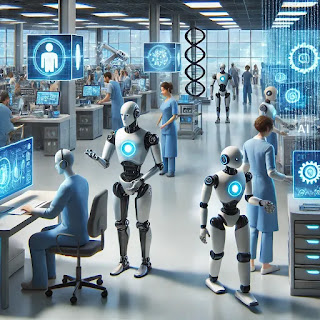The Rise of Humanoid Robots: How AI is Reshaping Workplaces
Introduction
Humanoid robots, once a sci-fi fantasy, are now a reality. With advancements in artificial intelligence (AI), machine learning (ML), and robotics, these futuristic machines are stepping into workplaces, handling tasks once exclusive to humans.
From customer service to warehouse automation, AI-powered humanoid robots are transforming industries, increasing efficiency, and challenging the traditional workforce.
But how are these robots changing the business landscape? And what does it mean for employees? Let’s explore.
1. What Are Humanoid Robots?
A humanoid robot is a machine designed to mimic human behavior, movement, and even expressions. Unlike traditional industrial robots, humanoids are built with AI capabilities, enabling them to:
✅ Walk, run, and move with human-like coordination
✅ Recognize voices and respond using NLP (Natural Language Processing)
✅ Interact with customers in retail and hospitality
✅ Handle repetitive tasks in manufacturing and logistics
✅ Assist in healthcare and elderly care
Real-World Example: Tesla Optimus & Agility Robotics’ "Digit"
- Tesla Optimus: An AI-powered bipedal robot designed to automate human tasks.
- Digit by Agility Robotics: A two-legged humanoid used for warehouse operations and package delivery.
These robots represent the next wave of automation, improving productivity while reducing human effort.
2. How Humanoid Robots Are Transforming Workplaces
🏭 Manufacturing & Logistics
- Cobots (Collaborative Robots) work alongside humans in assembly lines.
- AI-powered humanoids handle packaging, sorting, and quality control.
- Example: Amazon’s fulfillment centers use robots for warehouse automation.
🛒 Retail & Customer Service
- AI robots greet customers, provide information, and assist in checkouts.
- Example: SoftBank’s Pepper Robot interacts with customers in banks and stores.
🏥 Healthcare & Elderly Care
- Humanoid robots help with patient monitoring and elderly assistance.
- Example: "Grace," an AI-powered nurse robot, assists in elderly care homes.
🏢 Corporate & Office Automation
- AI-powered assistants handle administrative tasks.
- Example: AI robots schedule meetings and manage databases.
3. Benefits of Using Humanoid Robots
✅ Increased Efficiency: Robots can work 24/7 without fatigue.
✅ Cost Savings: Reduces the need for human labor in repetitive tasks.
✅ Better Accuracy: AI robots eliminate human errors in manufacturing.
✅ Enhanced Customer Experience: Faster and more interactive service.
Challenges & Ethical Concerns
❌ Job displacement: Will AI replace human jobs?
❌ High initial investment: Robotics implementation is costly.
❌ Ethical concerns: Can robots make unbiased decisions?
4. The Future of Humanoid Robots in the Workplace
- AI will make robots smarter, allowing them to learn and adapt.
- More industries will adopt humanoids, from education to security.
- Humans and robots will collaborate, creating a hybrid workforce.
The key is adaptation. Businesses need to reskill employees and integrate AI into workflows without completely replacing human intelligence.
Final Thoughts: Are We Ready for the AI Workforce?
Humanoid robots are no longer an experiment—they’re a business reality. From self-checkout assistants to AI-powered security bots, automation is here to stay.
👉 What do you think? Will humanoid robots help or replace human workers? Let us know in the comments! 🚀

Comments
Post a Comment